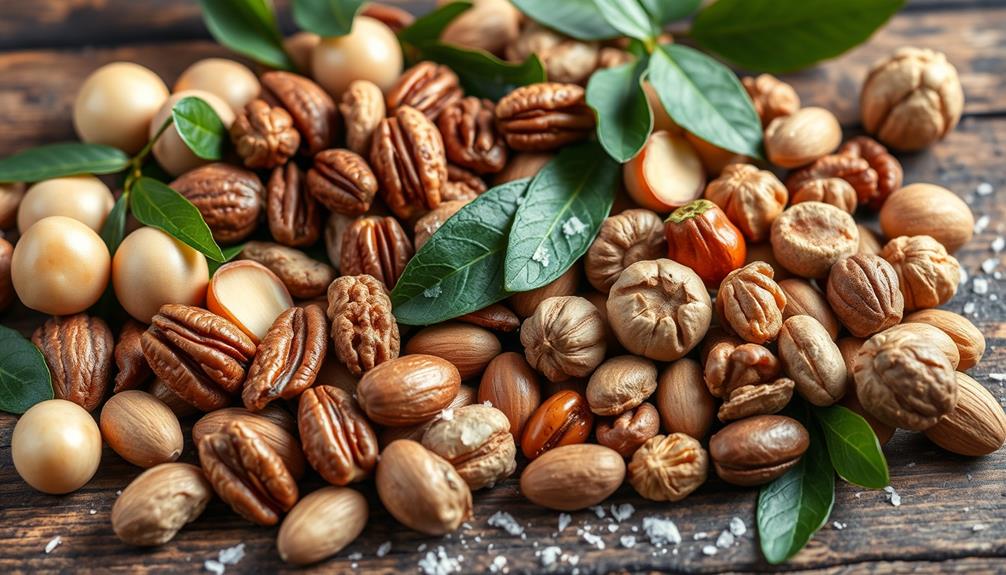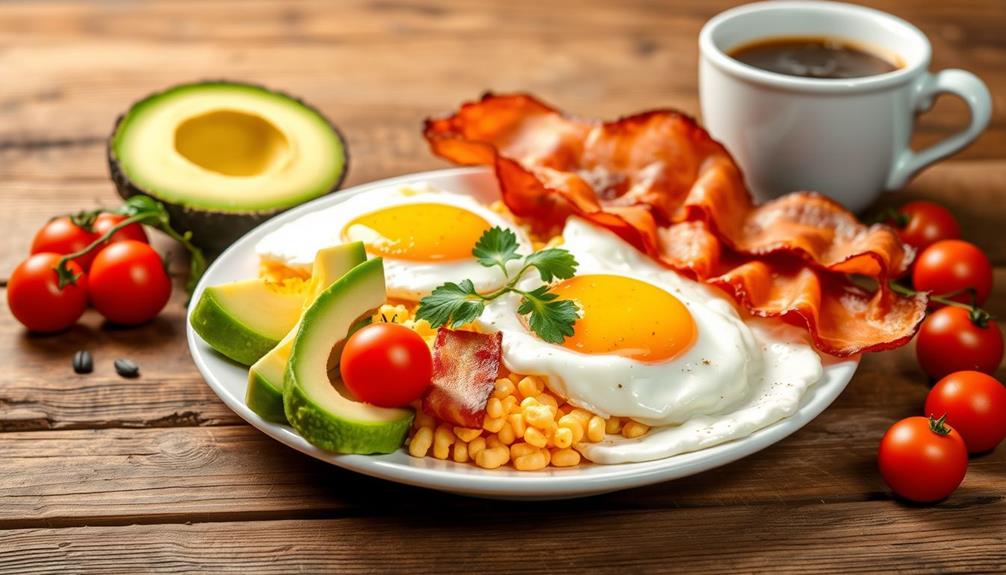To begin a keto diet, focus on drastically reducing your carbohydrate intake to 20-30 grams daily while increasing healthy fats to 70-80% of your total calories. Incorporate avocados, nuts, seeds, and fatty fish, and avoid high-carb foods like grains and most fruits. Prepping meals in advance can help you stick to your goals more easily. Stay hydrated, as this can alleviate potential side effects like fatigue or headaches. Remember to listen to your body during the change phase. There's much more to evaluate for a successful keto journey, and you'll discover valuable tips along the way. For more guidance, consider consulting a beginner’s guide to keto diet, which can provide comprehensive information on meal planning, macro tracking, and navigating social situations while following the keto lifestyle. It’s also helpful to connect with a community of like-minded individuals who can offer support and share their experiences. As with any significant dietary change, it’s important to consult with a healthcare professional before starting a keto diet, especially if you have any underlying health conditions. If you’re getting started with keto, remember that it’s not just about what you eat, but also about how you feel. Be mindful of your energy levels, mood, and overall well-being as you transition to this new way of eating. Don’t be afraid to make adjustments to your keto plan in order to find what works best for you. And finally, be patient with yourself. Getting started with keto may take some time and experimentation, but the potential benefits to your health and lifestyle can make it all worthwhile.
Key Takeaways
- Understand the keto diet's composition: focus on high fats (70-80%), moderate protein (15-20%), and limit carbs to under 50 grams daily.
- Incorporate healthy fats like avocados, nuts, and oils while avoiding high-carb foods such as grains and sugary snacks.
- Plan meals by limiting carbs to 20-30 grams daily and ensuring a high-fat focus for effective meal prepping.
- Stay hydrated by drinking 6-8 glasses of water daily and replenishing electrolytes to manage potential "keto flu" symptoms.
- Set clear fitness goals and tailor your keto approach to support your specific objectives while monitoring health metrics regularly.
Understanding the Keto Diet

When you immerse yourself in the Keto Diet, you're embracing a high-fat, low-carbohydrate lifestyle that can alter your body's metabolism. This ketogenic diet typically involves a meal plan where about 70-80% of your calories come from healthy fats, 15-20% from protein, and less than 50 grams of carbohydrates per day.
By drastically reducing your carbohydrate intake, your body enters a state known as ketosis, where it starts burning fat for energy instead of carbs. Additionally, incorporating nutrient-rich foods, like vegetables low in carbohydrates, can enhance your health during this change; consider the benefits of celery juice for its anti-inflammatory properties.
As you adapt to this low carb diet, you'll likely experience weight loss, especially in the initial stages. Your liver converts fats into ketones, providing an alternative energy source for your brain and leading to improved insulin sensitivity.
While many find the quick results motivating, it's crucial to recognize that the Keto Diet is primarily designed for short-term use. Long-term adherence could lead to potential health risks and nutrient deficiencies.
There are various Keto variants, including the Standard Ketogenic Diet (SKD) and High-Protein Ketogenic Diet (HPKD), allowing you to tailor your protein intake and fat sources to fit your lifestyle.
Ready to explore this transformative journey?
Key Foods for Keto

As you commence your Keto journey, knowing which foods to include is crucial for maintaining ketosis and achieving your health goals. The key foods for keto should primarily consist of healthy fats, which will make up about 70%-80% of your daily caloric intake. Focus on avocados, nuts, seeds, and fatty fish to help you stay satisfied and energized.
Additionally, incorporating effective strategies for weight loss can further enhance your progress and motivation on this dietary path.
Incorporate plenty of non-starchy vegetables, like leafy greens, broccoli, and cauliflower. These low-carb options provide important vitamins and minerals without spiking your blood sugar levels. Aim for moderate amounts of high-quality proteins, such as red meat, chicken, and eggs, ensuring they account for about 15%-20% of your total calories. This will help prevent excess glucose production while supporting your weight loss goals.
Avoid high-carb foods like grains, sugary snacks, and most fruits—except for small portions of berries—if you want to maintain ketosis effectively.
Additionally, healthy fats from olive oil, coconut oil, and butter are crucial for managing hunger and promoting satiety throughout the day. By adhering to these dietary restrictions, you'll be well on your way to successful low-carb diets and peak health.
Meal Planning Essentials
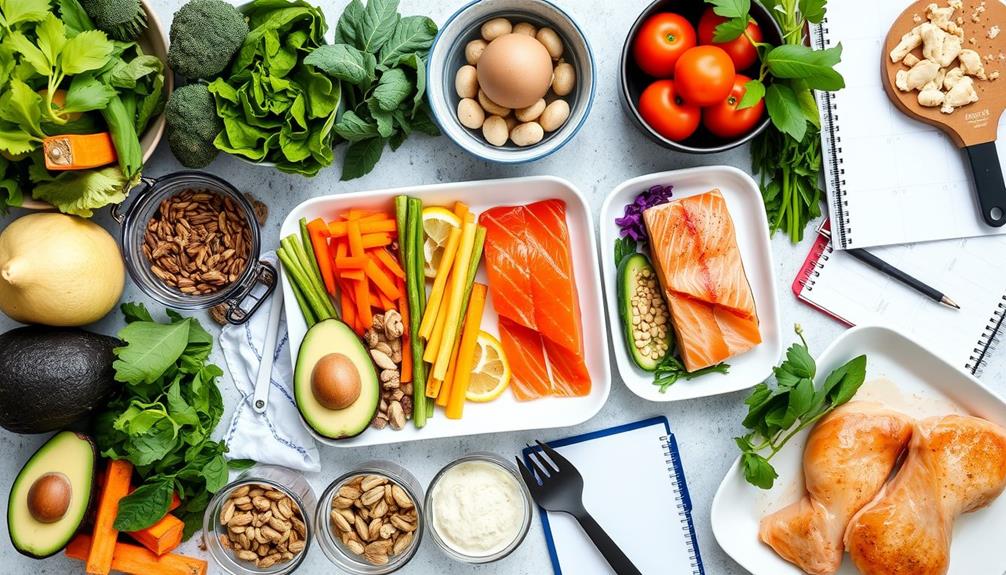
Successful meal planning is your best ally in the Keto Diet, guaranteeing you stick to your carb limits while enjoying delicious, satisfying meals. To thrive on this restrictive diet, you'll need to limit carbohydrates to 20-30 grams per day and confirm that 70-80% of your caloric intake comes from healthy fats.
Focus on incorporating high-fat foods like avocados, nuts, seeds, oils, and fatty fish, while steering clear of starchy vegetables, grains, and sugary treats. Understanding the mechanics of meal prep can enhance your planning experience, much like how different brewing methods affect coffee flavor.
Meal prepping is vital for maintaining your diet. Batch cooking and preparing meals in advance allow you to have keto-friendly options readily available throughout the week.
Keep a variety of keto-friendly snacks on hand, such as cheese, hard-boiled eggs, and nuts, to manage hunger and prevent cravings between meals.
Utilizing meal planning apps or journals can help you track your macronutrient intake, confirming you meet your dietary goals. This is essential for entering ketosis and maintaining your state.
Managing Keto Side Effects
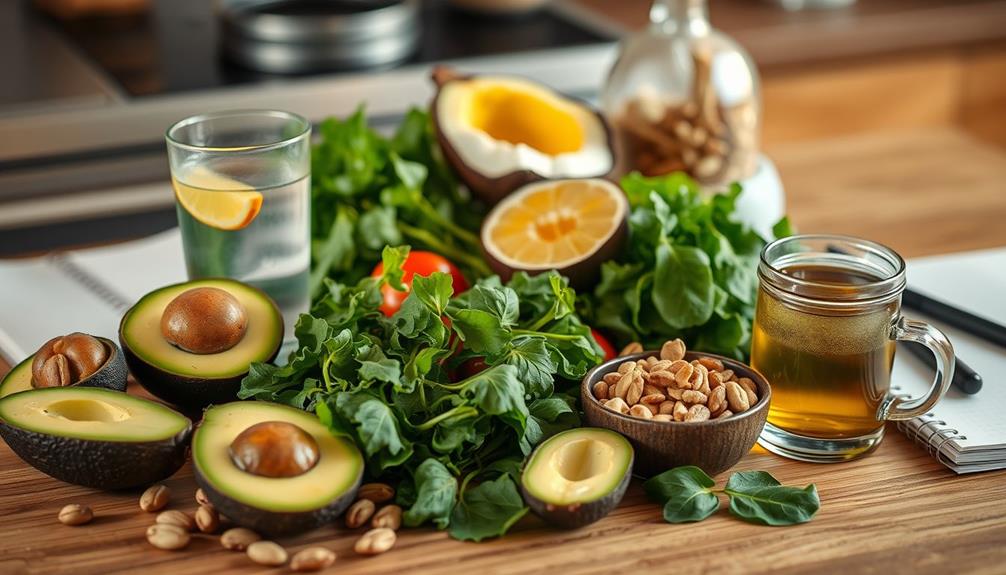
As you start your keto journey, you might experience some common side effects, often referred to as "keto flu."
These symptoms can include fatigue, headaches, and nausea, but there are effective ways to manage them. Staying hydrated is essential, as dehydration can exacerbate these symptoms.
Additionally, adjusting your electrolyte intake, particularly sodium, potassium, and magnesium, can help mitigate discomfort during this shift natural remedies alongside conventional medications.
Common Side Effects
Many people experience side effects when starting a keto diet, often referred to as the "keto flu." This temporary phase can bring symptoms like fatigue, headaches, nausea, and cramping as your body adapts to burning fat for fuel instead of carbohydrates.
It's important to recognize these side effects and manage them for a smoother adjustment. Incorporating practices like regular stretching or meditation can also help alleviate stress during this adjustment period, much like the benefits seen in yoga practices for managing discomfort and tension yoga for back pain.
Here are some common side effects you might encounter:
- Fatigue: As your body adapts to a high-fat diet, you may feel more tired than usual.
- Headaches: Dehydration and electrolyte imbalances can lead to headaches during the adjustment.
- Digestive Issues: Changes in macronutrient ratios might cause constipation or diarrhea.
- Muscle Cramps: Low electrolyte intake can contribute to cramps as your body adjusts.
To ease these symptoms, focus on hydration and guarantee adequate electrolyte intake, particularly sodium and potassium.
Gradually adapting to a low-carb diet can also help minimize discomfort. Engaging in regular physical activity, especially low-intensity exercises, can support your body as it adjusts to ketosis and utilize fat for energy more efficiently.
Mitigating Keto Flu
Experiencing keto flu can be frustrating, but there are effective strategies to ease these symptoms. First, prioritize hydration. As your body adjusts, it loses more water and electrolytes, which can lead to fatigue and headaches. Increasing your intake of sodium, potassium, and magnesium can greatly help.
Additionally, understanding the importance of budgeting for health expenses can help you plan for any necessary supplements or groceries that may support your keto journey. Gradually reducing your carbohydrate intake over a week, rather than cutting it abruptly, will make your shift into ketosis smoother and lessen flu-like symptoms.
Incorporate high-fat foods like avocado, nuts, and healthy oils into your meals to maintain energy levels during the adaptation phase. Consuming bone broth is another excellent way to replenish electrolytes and stay hydrated.
Additionally, engaging in light physical activity, such as walking, can boost your energy and support the shift into ketosis, helping to alleviate discomfort.
Importance of Hydration

Hydration plays an essential role in your success on a keto diet. As you reduce carbohydrates, your body loses more water, which can lead to dehydration if you're not careful. Staying hydrated helps support your metabolic processes and can ease symptoms of the dreaded "keto flu."
This is particularly important as you may also consider diversifying your investments, such as exploring precious metal options to secure your financial future. Aim to drink at least 6-8 glasses of water daily, adjusting for exercise and heat.
Here are four hydration tips to keep you on track:
- Monitor Your Water Intake: Keep track of how much water you're drinking to guarantee you're meeting your hydration goals.
- Incorporate Electrolytes: Add broth to your meals or sprinkle some salt to replenish sodium and potassium lost through increased urination.
- Address Thirst Immediately: Don't mistake thirst for hunger; staying hydrated can help you avoid unnecessary snacking.
- Be Aware of Dehydration Symptoms: Watch for signs like fatigue or dizziness, which can worsen during the shift to a ketogenic diet.
Assessing Your Fitness Goals

Setting clear fitness goals is essential when starting a keto diet, as it gives you a roadmap for your journey. Begin by evaluating your current weight and body composition to determine a realistic weight loss goal. Many individuals experience an average initial weight loss of 2-10 pounds in the first week on a ketogenic diet, which can boost your motivation.
Additionally, understanding the potential financial considerations for maintaining a healthier lifestyle can be beneficial, especially if you're planning long-term dietary changes financial considerations for elderly care.
Next, identify specific fitness goals such as fat loss, improved energy levels, or increased muscle definition. Tailoring your macronutrient ratios to support these objectives can make a significant difference.
Consider your activity level; if you're engaged in high-intensity workouts, a Targeted Ketogenic Diet (TKD) may be beneficial, allowing for carb intake around workout times.
Don't overlook any pre-existing health conditions, like diabetes or metabolic syndrome, as these can influence your approach to keto and improve insulin sensitivity.
Finally, set a timeline for your fitness goals. Many find that consistent adherence to the keto diet for at least 3-6 months leads to substantial changes in body composition and health markers.
With clear goals, you're more likely to stay committed and see results.
Long-Term Dietary Considerations
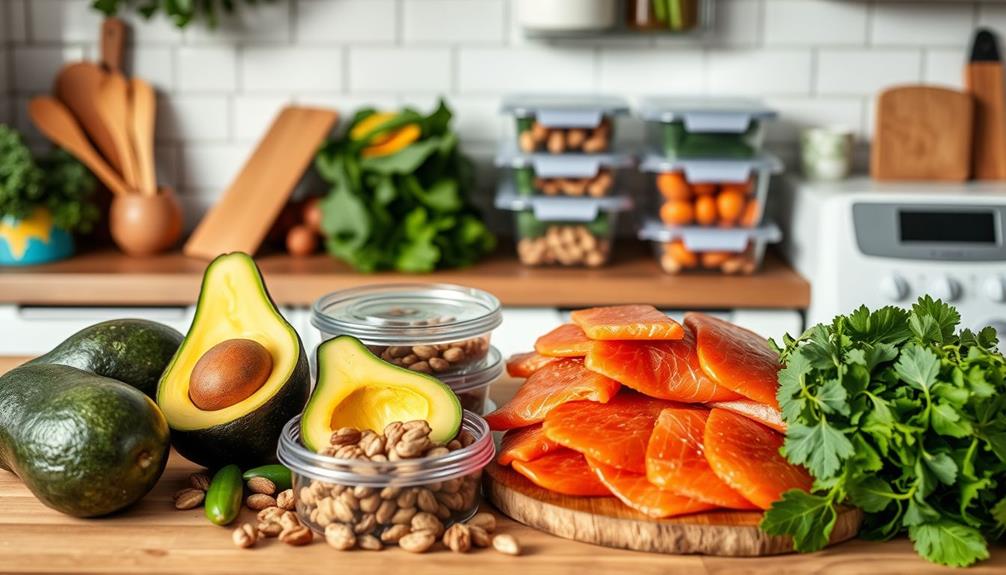
As you work toward your fitness goals, it's important to think about how to maintain your progress after the initial phase of the keto diet. Long-term adherence can be challenging, so you'll want to focus on creating sustainable eating habits that support your long-term weight loss.
Additionally, guaranteeing a balanced diet is essential, as seen in the Ultimate Hamster Care Guide, which emphasizes the importance of a proper diet for overall health.
Here are some key considerations for your post-keto journey:
- Reintroduce Healthy Carbohydrates: Gradually incorporate healthy carbohydrates, focusing on non-starchy vegetables and whole foods.
- Monitor Health Markers: Regularly check your cholesterol levels and metabolic health to verify your dietary choices remain beneficial.
- Balance Your Macronutrients: Aim for a diet rich in balanced macronutrients to avoid nutrient deficiencies while supporting overall health.
- Engage in Physical Activity and Seek Support: Regular exercise and social support can greatly enhance your success in maintaining healthy eating habits.
Frequently Asked Questions
What Is the Correct Way to Start Keto?
To start keto correctly, you'll want to cut carbs considerably, focus on healthy fats, and prepare meals in advance. Stay hydrated, manage electrolytes, and gradually shift to minimize any discomfort during the adjustment phase.
How Do Beginners Get Into Ketosis?
To get into ketosis, you'll need to cut carbs drastically, boost healthy fat intake, and consume moderate protein. Monitor your ketone levels and stay hydrated to ease through the initial shift phase effectively.
What Are the Basic Rules for Keto?
To succeed on keto, limit carbs to 20-50 grams daily, focus on healthy fats for 70-80% of your intake, choose low-carb veggies, and stay hydrated while managing electrolytes to avoid the "keto flu."
How Do I Kick Start a Ketogenic Diet?
To kickstart a ketogenic diet, you'll want to drastically cut carbs to 20-50 grams daily. Focus on high-fat foods, stay hydrated, and gradually decrease carbs to ease into ketosis without severe side effects.
Conclusion
Starting a keto diet can be a rewarding journey toward better health, but it's crucial to stay informed and prepared. By understanding the key foods, planning your meals, and managing side effects, you'll set yourself up for success. Remember to hydrate and assess your fitness goals along the way. So, are you ready to embrace a lifestyle that could transform your energy levels and overall well-being? Immerse yourself and discover the benefits for yourself!

